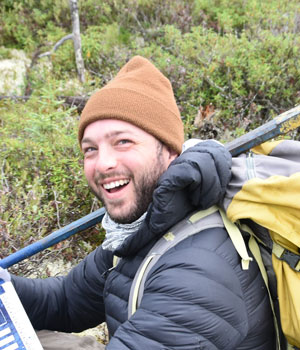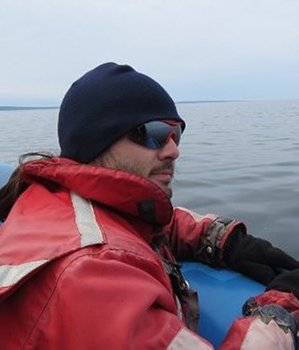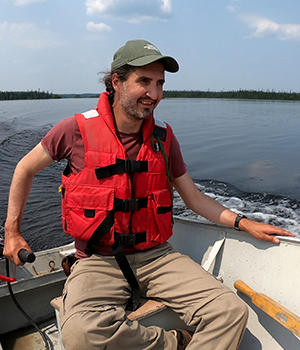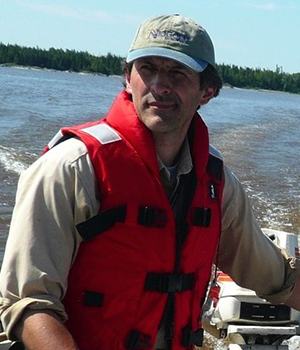Géologie Québec presents the results and unpublished interpretations of projects carried out in the summer of 2022 in Nunavik (Serpentine Lake and Nuvilic Lakes) and Abitibi (Alouettes Creek and Dickson Lake). The interim results of an initial metallogenic study of lithium in Abitibi will also be unveiled. The session will be closed by a presentation from our guest speaker to provide an historical perspective on the geology of the Malartic and Louvicourt Groups.
Geoscientific Knowledge Acquisition by Géologie Québec and its Partners – Nunavik and Abitibi
Tuesday, November 21, 2023
Room 403 - Geoscientific Pavilion


9:35 a.m.
Geology of the Serpentine Lake Region, Ungava Orogen, Nunavik, Quebec, Canada

MRNF
Authors: Guillaume Mathieu, Marc-Antoine Vanier and Thomas Debruyne (MRNF)
The summer 2022 field campaign covered the Serpentine Lake region. The western parts of NTS sheets 35G10 and 35G15 were mapped at a hybrid scale between 1:20,000 and 1:50,000. Verification was also carried out in the eastern portion of sheet 35G15 to improve understanding of the central sector.
The geology of this region is made up of two Palaeoproterozoic groups, each accounting for around half of the area mapped in 2022. The first is made up of supracrustal rocks (Iqiattavialuk Formation, Spartan and Parent Groups) cut by intrusions concordant with the volcano-sedimentary pile (Sanimualuk and Sanimuapik Suites). The second group, to the north, consists of the Vanasse Suite. The junction of these two groups is characterized by a complex polyphase folding pattern, the presence of minor discontinuous shear zones, and an abrupt northward increase in the metamorphic gradient. Two late suites (Illuinaqtuut and Niqituraaqiaruk Suites) cut all the units in the sector.
The complex structural pattern, already highlighted in previous work, has been more clearly defined. It results from the interference of three families of folds known as P1, P2 and P3. The P1 family is made up of upright axial folds oriented E-W with a subhorizontal hinge dipping towards the west. The P2 family, which is the most represented, forms tight to isoclinal folds with overturned axial planes and hinges dipping moderately in a NW to NNE direction. This family is synchronous with the activity of the Ombilic Thrust Fault. Folds P1 and P2 are part of the same deformation continuum. The P3 family of folds is made up of upright or overturned axial plane folds trending mainly N-S with a hinge dipping slightly to the north.
9:50 a.m.
Geology of Surface Deposits in the Nuvilic Lakes Region, Nunavik, Quebec, Canada

MRNF
Authors: Simon Hébert, Marc-Antoine Lévesque (MRNF) and Alex Proulx (UQAM)
To the north of the Ungava Peninsula, the great glaciations of the Quaternary shaped the morphology of a large part of the territory by depositing a sedimentary layer of varying thickness, thus limiting access to the bedrock. For this reason, the use of glacio-sedimentary prospecting tools is proving to be a great help in painting a more global picture of the mineral potential of the Nunavik region, which is already renowned for its nickel potential (2 active mines). This presentation deals with the Quaternary geology of an area covering just over 4,500 km2 in the central sector of the Ungava Peninsula, south of Salluit and Deception Bay. A new 1:50,000 scale map of surface formations and a sampling of glacial (till) and glaciofluvial (esker) sediments were carried out during the field campaign in the summer of 2021. The study area is bordered to the south by the Cape Smith Belt, a lithotectonic domain belonging to the Ungava Orogen. Surface deposits are dominated by glacial deposits (till), which in places were reworked and incised by meltwater during deglaciation. Ice-contact glaciofluvial deposits (eskers) of predominantly sandy-gravel composition, as well as proglacial spreading, locally overlay glacial deposits. There is considerable evidence of the existence of glacial lakes of varying duration and size that reworked or covered the glacial and glaciofluvial deposits in the valleys of the Foucault and Gatin Rivers. The presence of glaciomarine terraces and deltas can also be seen, making it possible to delineate the maximum extent of the marine invasion in the valley of the Françoys-Malherbe and Watts lakes. The study area is located in the heart of the Ungava Peninsula and shows little macroscopic evidence of glacial flow (tapered terrain shapes), despite the numerous striations visible on the outcropping rock. The bedrock is scarcely exposed in the study area, generally gelifracted and characterized locally by mature felsenmeer, particularly on the Puvirnituq mountains.
10:05 a.m.
Geology of the Lac la Trêve Area, Abitibi Subprovince, Eeyou Istchee James Bay, Quebec, Canada

MRNF
Authors: Mélanie Beaudette and Yannick Daoudene (MRNF)
As a result of a survey carried out in the summer of 2022, a new geological map at a scale of 1:20,000 has been produced for the Ruisseau aux Alouettes region (sheet 32G13-SE), located ~60 km west of the town of Chapais. Our observations provide an unprecedented subdivision of the volcanic rocks in the southern half of the region, which were previously grouped indiscriminately in the Blondeau Formation (top of the second volcanic cycle of the Roy Group). We propose to divide these rocks into nine subunits variably composed of volcanic rocks, i.e. massive or pillowed mafic to felsic lava, intermediate volcaniclastic rocks and detrital sedimentary rocks. To the south, the Blondeau Formation is in stratigraphic contact with the mafic volcanic rocks of the Bruneau Formation (base of the second volcanic cycle of the Roy Group). To the south, the Bruneau Formation is in tectonic contact with the Lapparent Intrusive Suite, made up of various units of intermediate to felsic intrusive rocks. To the north, the detrital sedimentary rocks of the Daubrée Formation and the Opémisca Group are in tectonic contact with the Blondeau Formation. The latter is cut by the gabbros and ultramafic intrusive rocks of the Sturgeon Sill, now assigned to the Cummings Intrusive Suite, and by the late tectonic or post-tectonic La Ribourde Pluton. The Daubrée Formation is cut by three intrusions belonging to the Daine Intrusive Suite: the Rita, Amibe and Saussure Plutons. Most of the polarity criteria observed in the Blondeau and Daubrée Formations show a stratigraphic top towards the NE. However, a few polarities to the south indicate that the volcano-sedimentary sequence in the region is affected by generally tight folds, with low-dip axes and axial plane traces parallel to the regional structural grain. In addition to the base and precious metal mineralized zones already identified in the region, our work highlighted four promising sectors associated with the presence of: 1) zones of volcanogenic alteration and massive sulphides in pillowed intermediate volcanic rocks of the Blondeau Formation (nAbl2b); 2) fragments of massive sulphides in intermediate volcaniclastic rocks containing bluish quartz crystals from the Blondeau Formation (nAbl2f); 3) anomalous values of vanadium and titanium in an iron-rich quartz gabbro of the Sturgeon Complex (nAest2b); and 4) epidote ± sulphide alteration zones in volcanic units on the periphery of the La Ribourde Pluton that bear similarities to a skarn-type metallogenic context.
10:20 a.m.
Break
10:35 a.m.
Petrogeochemical Characterization and Role of Deformation in the Formation of Lithium Deposits in the la Motte-la Corne Area, Abitibi Subprovince, Quebec

MRNF
Author: Hubert Mvondo (MRNF)
Lithiniferous pegmatites and associated facies in the La Motte La Corne region form felsic domes and Iodes injected along faults at the edge of granodiorite and monzogranite plutons. They are mainly composed of quartz, albite, K-feldspar, spodumene and accessory minerals are spessartine, muscovite and beryl, defining aplitic and porphyritic to equigranular textures. These textures result from at least 4 phases of magmatic and magmatic-hydrothermal crystallization, including the formation of 2 generations of spodumene, the principal lithiniferous mineral.
The felsic Iodes have an alkaline syenite-granite composition with varying grades of SiO2 (64.65-79.64%), Al2O3 (10.61-24.88%), Na2O + K2O (4.39-11.74%), Li (12-22500 ppm), Cs (0-431 ppm), Ta (8-366 ppm), Rb (5-3130 ppm), Sr (5-285 ppm), Be (5-428 ppm), Ba (2-404 ppm), P (2-742 ppm), F (0.01-0.22 ppm) and ƩREE (2-83 ppm). These peraluminous rocks (Al/(Ca + Na + K) = 1.51-3.59) are the result of several injections of a source magma derived from the partial melting of metapelites at the base of the crust, and which differentiated on ascent to the surface into the magmatic-hydrothermal stage. Similar geochemical characteristics are indicated by monzogranites representing primitive intrusions of source magma.
Lithiniferous pegmatites, derived from the most differentiated facies of the source magma rich in fluxing elements (H2O, F, P, etc.), were emplaced by faults and associated damage zones at the edge of granodiorite and monzogranite plutons. Thus, peraluminous plutons and major faults located near these plutons can be used as indicators for the exploration of lithiniferous pegmatites.
10:50 a.m.
Historical Look at the Geology and Architecture of the Malartic and Louvicourt Groups, Abitibi Subprovince

MRNF
Authors: Pierre Pilote, James Moorhead, Pierre Lacoste (MRNF), Réal Daigneault (UQAC) and Pierre Bedeaux (Barrick Gold)
The stratigraphic and structural framework of the Malartic and Louvicourt groups, clearly exposed in the Val-d'Or-Malartic region, has greatly evolved since the pioneering work of James and Mawdsley (1925), Gunning and Ambrose (1939 and 1940) and Norman (1941, 1942 and 1944). On the Quebec side, the work of Latulippe (1966), Sharpe (1968), Imreh and collaborators (which spanned more than a decade, from 1974 to 1984), and Rocheleau and collaborators (1997) refined this pattern. This presentation will focus on the architecture and our understanding of the Louvicourt and Malartic groups and adjacent geological units (volcanic, sedimentary and intrusive). Findings and interpretations will be presented in the light of MRNF's mapping campaigns over the past 35 years, supported by a selection of key outcrops, numerous U-Pb dates on zircons, university studies and mining work of decisive interest carried out and/or commissioned in several cases by this ministry, and high-resolution aeromagnetic geophysical surveys.
The Malartic and Louvicourt groups, located in the SE part of the Archean Abitibi Subprovince, show a WNW-ESE orientation and occupy a total area of approximately 125 x 18 km2. These lithostratigraphic packages show southward rejuvenation that is generally consistent with the polarities observed. The Malartic Group comprises, from base to top, the La Motte-Vassan (FLM; 2714±2 Ma), Dubuisson (FD; 2708±2 Ma) and Jacola (FJ; 2703±2 Ma) formations. At its base, the Louvicourt Group contains the Val-d'Or Formation (FVO; 2704±2 Ma), topped by the Héva Formation (FH; 2702 to 2698 ±2 Ma). Benchmark horizons have enabled stratigraphic correlations to be established and demonstrated that facies mapping can be used successfully, despite the fact that these two groups represent a stratigraphically, geochemically and geochronologically complex volcano-sedimentary sequence.
The Malartic Group is the equivalent of an ocean floor, probably produced at great depth by a mantle plume. Stratigraphically above the Malartic Group, the FVO represents the construction of a volcanic arc with numerous superimposed effusive centers. The contact between the FJ and the FVO is gradual, reflecting the transition from ultramafic/mafic towards intermediate to felsic volcanism. The top of the Louvicourt Group is characterized by basaltic flows and volcaniclastic rocks of the FH. The stratigraphic assemblage established by mapping, volcanology, sedimentology and geochronology, collectively suggests that this region constitutes a coherent and cohesive, but obviously severely faulted, deformed and metamorphosed, volcano-sedimentary succession, rather than a collage of unrelated allochthonous domains. The Ontario counterpart of these lithologies is partly found in the Kidd-Munro episode (assemblage). However, there are significant differences between these two ensembles.